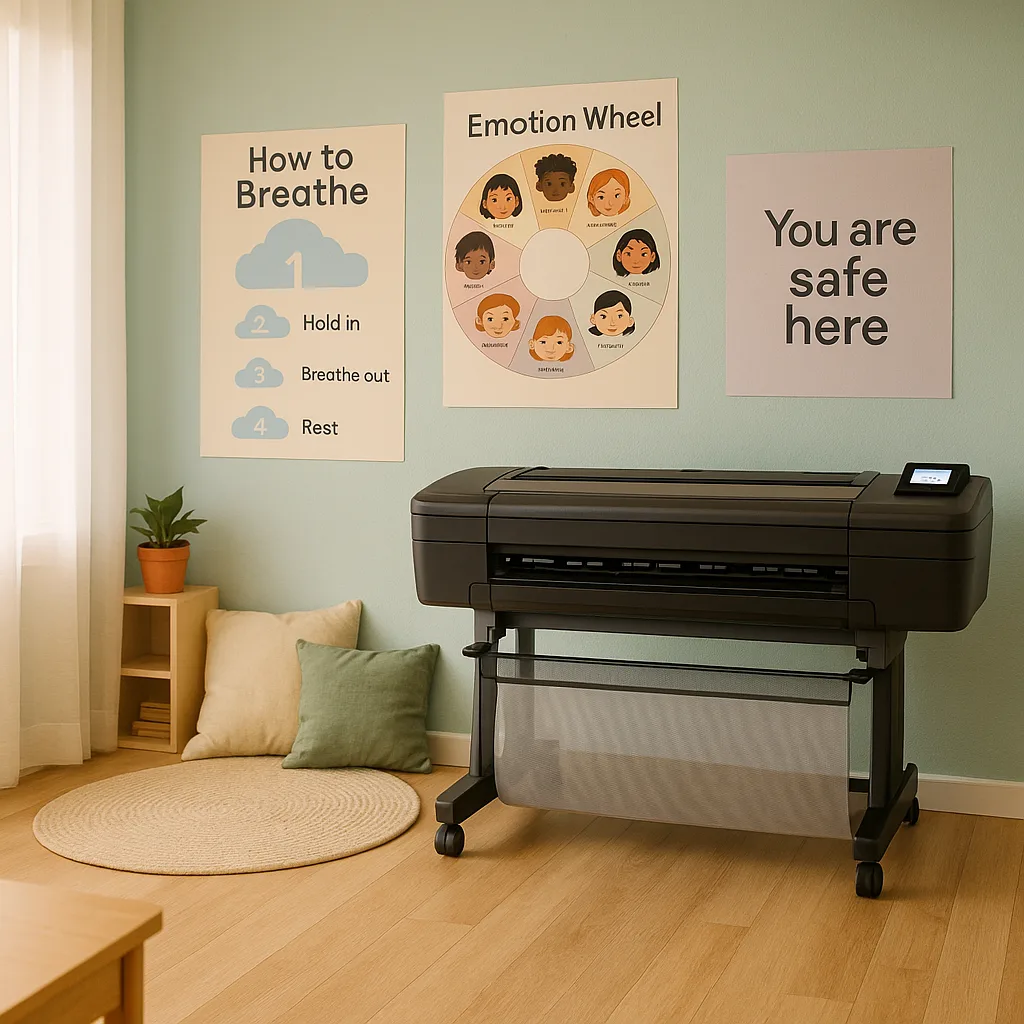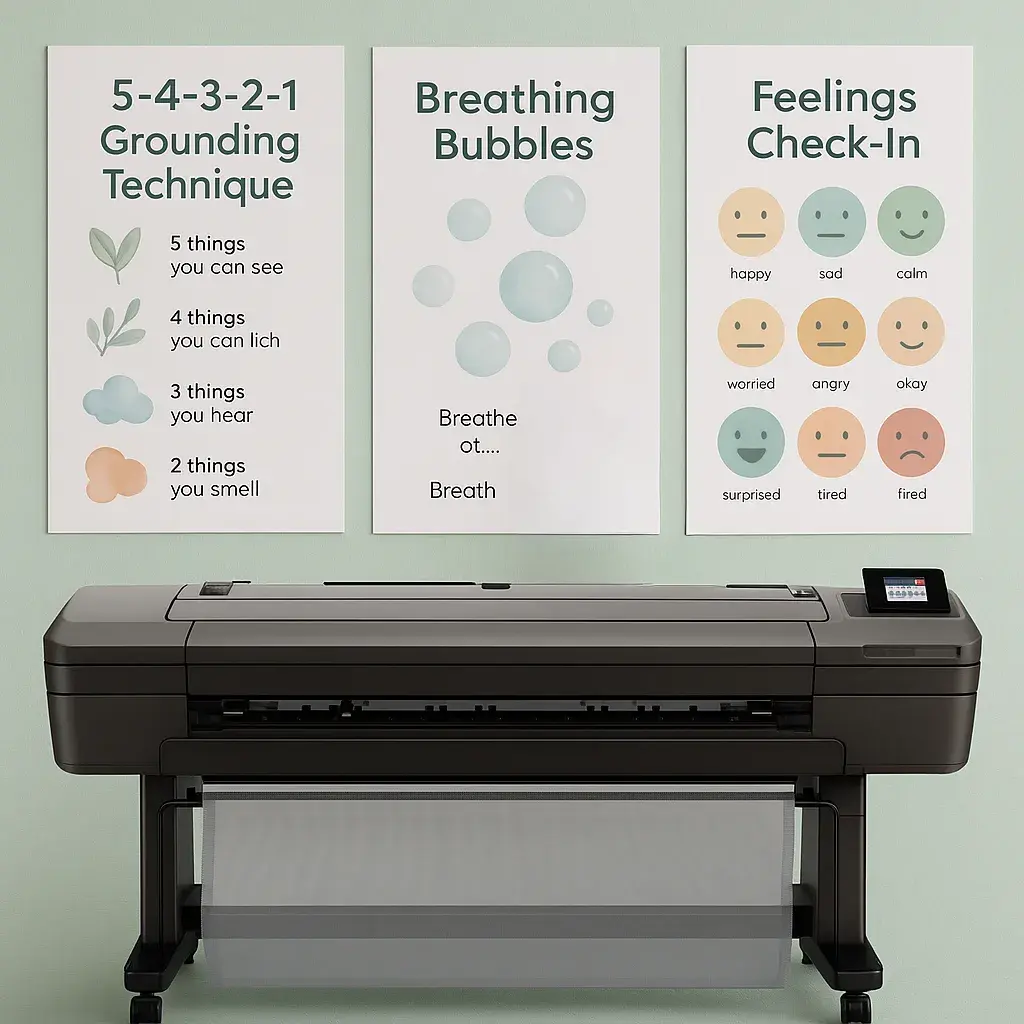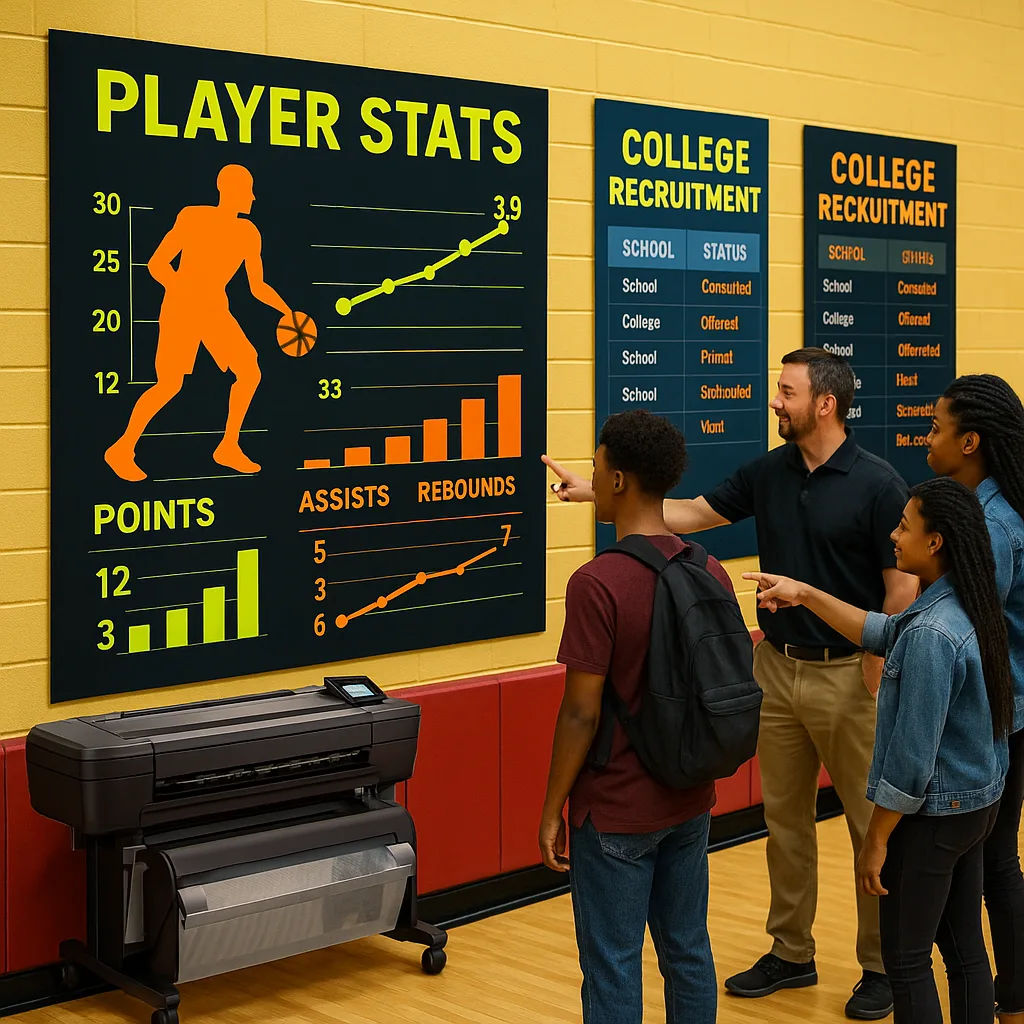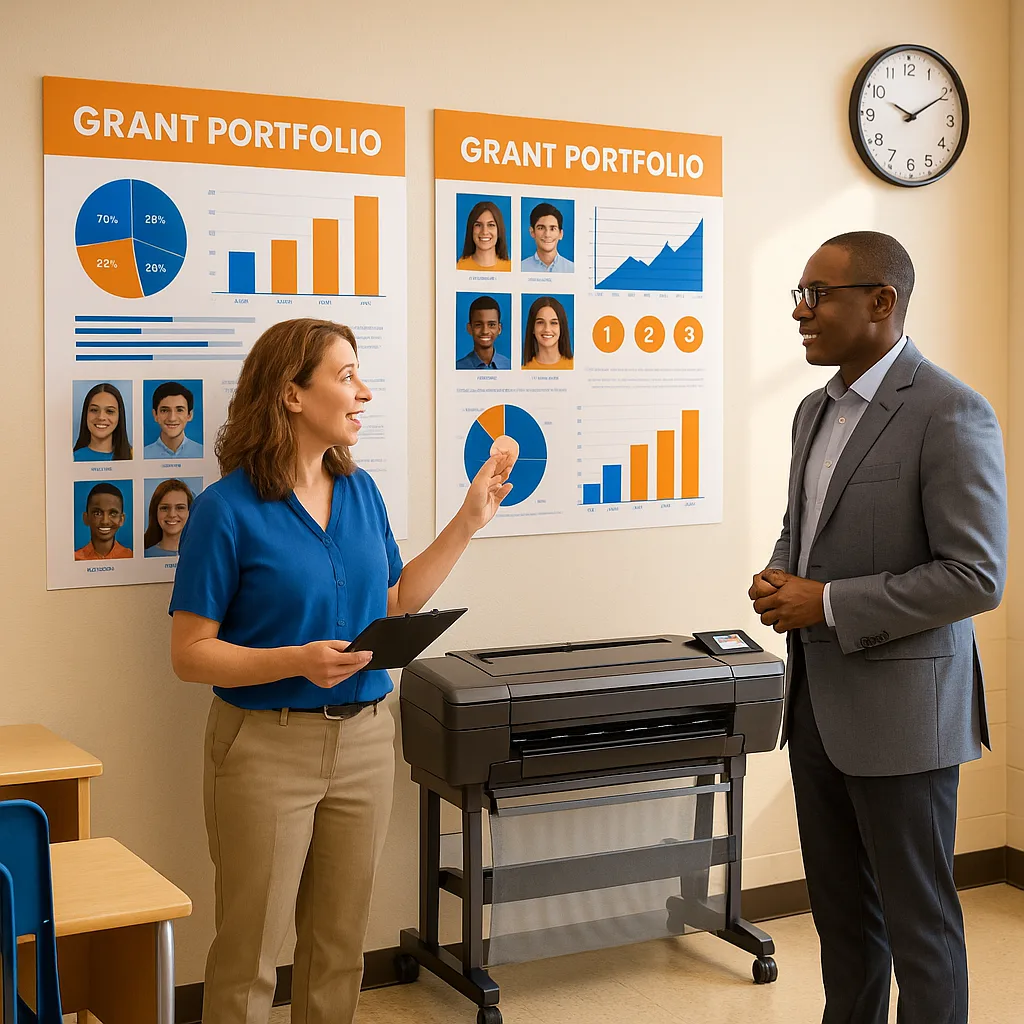
Walking into my classroom this morning, I noticed Maya hovering by the door again. She’s done this every day since joining our class mid-year, scanning the room before entering. That’s when I realized our bright red “Welcome!” banner might feel more like a warning sign to a child carrying invisible wounds. After researching trauma-responsive design and investing in our school’s poster print machine, I’ve discovered how thoughtful visual environments can transform anxious hovering into confident belonging—and I’m excited to share what I’ve learned about creating poster print machine trauma spaces.

Understanding Trauma’s Impact on Visual Processing
Research from the National Child Traumatic Stress Network shows that trauma fundamentally changes how children process visual information. Furthermore, their brains often remain in a state of hypervigilance, constantly scanning for threats. This means that chaotic or unpredictable visual environments can trigger stress responses before a single word is spoken.
Dr. Sarah Martinez, our district’s lead counselor, explained it perfectly during our professional development session: “For trauma-affected students, every poster, every color choice, every visual element either whispers ‘you’re safe here’ or screams ‘danger ahead.'” Therefore, when we understand this neurological reality, we can design spaces that actively support healing rather than inadvertently triggering distress.
Poster Print Machine Trauma Spaces: The Foundation
Creating trauma-responsive visual environments starts with consistency and predictability. Using our school’s poster print machine, I’ve developed a systematic approach that our counseling team now recommends district-wide. First, we establish visual anchors—consistent elements that remain unchanged throughout the year. These might include calming corner signage, daily schedule displays, or emotional regulation charts.
The beauty of having a cost-effective poster printing solution means we can create multiple versions of essential visuals. For instance, I print smaller “pocket versions” of our calm-down strategies for students to keep at their desks. This redundancy provides security—if the main poster feels too far away during a difficult moment, students have their personal copy within reach.
Color Psychology in Trauma-Responsive Design
Not all colors soothe equally, especially for students whose nervous systems remain on high alert. Through collaboration with our school psychologist and extensive testing with our poster print machine, we’ve identified specific color palettes that promote regulation:
Blues and Greens (Pantone 5425C and 5535C): These nature-inspired hues lower heart rates and reduce cortisol levels. Consequently, they form the foundation of our calming corner displays.
Soft Purples (Pantone 5285C): Research indicates purple can reduce anxiety while maintaining alertness—perfect for learning spaces where students need to feel both safe and engaged.
Warm Neutrals (Pantone 7506C): These create a sense of stability without overwhelming sensitive nervous systems. As a result, they work beautifully as background colors for instructional posters.
When selecting materials for our poster making machine price comparison showed that investing in quality matte paper reduces glare—a often-overlooked trigger for students with trauma-related sensory sensitivities. The Satin Photo Paper has become our go-to choice for creating soothing, non-reflective displays.
Imagery Selection: What Heals vs. What Harms
Choosing appropriate imagery requires understanding how trauma affects visual interpretation. Surprising or ambiguous images can trigger hypervigilance, while predictable, nature-based visuals promote calm. Here’s what our trauma-informed team recommends:
Healing Imagery Includes:
– Soft, rounded shapes rather than sharp angles
– Nature scenes with clear horizons (providing visual stability)
– Diverse faces showing genuine, subtle emotions
– Animals in restful poses
– Abstract patterns with gentle, flowing movements
Potentially Triggering Imagery to Avoid:
– Isolated figures or shadowy silhouettes
– Crowded, chaotic scenes
– Intense facial expressions, even positive ones
– Sudden movement or action shots
– Dark corners or ambiguous spaces
Using Poster Studio Express’s lifetime design service, I worked with their human designers to create custom imagery that meets these criteria perfectly. Unlike AI-generated designs, their team understood the nuance needed for trauma-responsive materials.
Strategic Placement for Maximum Support
Where we place our posters matters as much as what they contain. Through careful observation and student feedback, I’ve learned that poster print machine trauma spaces require thoughtful positioning:
Entry Points: Welcoming, predictable visuals that remain constant. I use our poster print machine to create seasonal variations of the same basic “You Belong Here” message, maintaining familiarity while acknowledging change.
Transition Zones: Areas between activities need visual cues for what comes next. Subsequently, our sequential instruction posters use consistent formatting with gentle color coding to reduce transition anxiety.
Safe Spaces: Calming corners require special attention. Position regulatory posters at seated eye level, ensuring students can access visual supports without standing or drawing attention to themselves.
Learning Areas: Instructional posters should create clear visual boundaries without feeling constraining. Therefore, I use our poster making machine price advantage to create multiple smaller posters rather than one overwhelming display.
Creating Predictable Visual Environments
Predictability doesn’t mean boring—it means thoughtful consistency that helps students feel secure. Here’s our tested framework:
1. Establish Visual Routines: Morning check-in posters remain in the same spot all year. Students know exactly where to look for today’s schedule, weather, and class jobs.
2. Use Consistent Formatting: All instructional posters follow the same template: title at top, main content in the center, summary at bottom. This reduces cognitive load for processing new information.
3. Signal Changes Gradually: When updates are necessary, I print transitional versions. For example, rather than suddenly replacing our morning routine poster, I’ll add a small “Coming Soon” banner a week before, giving students time to prepare for change.
4. Maintain Visual Breathing Room: Trauma-affected students often feel overwhelmed by visual clutter. Consequently, I ensure 30% of wall space remains blank, providing visual rest areas.
Calming Corner Essentials
Every trauma-responsive classroom needs a designated calm-down space. Using our poster print machine, I’ve created a comprehensive calming corner kit that other teachers now request regularly:
Breathing Exercise Posters: Simple, illustrated instructions for box breathing, finger breathing, and bubble breathing. Each technique gets its own poster with consistent, soothing colors.
Emotion Identification Charts: Feeling faces with subtle expressions and emotion words in multiple languages, respecting our diverse student body while avoiding overwhelming options.
Grounding Technique Guides: 5-4-3-2-1 sensory grounding posters with soft, matte finishes that won’t create glare during vulnerable moments.
Positive Affirmations: Student-generated messages of encouragement, printed on Coated Poster Paper for durability since these get touched frequently.
The poster making machine price for creating these materials proves incredibly cost-effective compared to purchasing pre-made therapeutic posters. Plus, customization ensures cultural relevance and student voice inclusion.
Safe Space Signage Templates
Clear, consistent safe space signage helps students identify where they can go for support. I’ve developed several templates that our counseling team now uses school-wide:
“Peace Corner” Signs: Featuring soft cloud imagery and minimal text, these mark quiet regulation spaces without stigmatizing language.
“Check-In Station” Displays: Morning emotional check-in boards with movable pieces, allowing students to communicate their needs non-verbally.
“Strategy Menu” Posters: Visual choice boards showing different coping strategies, organized from least to most intensive support.
“Help Signal” Cards: Discrete visual cues students can display when needing support, printed small enough to fit on desks or in pockets.
Counselor Collaboration and Input
Mrs. Rodriguez, our school counselor, has become my closest collaborator in creating trauma-responsive visual environments. She emphasizes that effective poster print machine trauma spaces require ongoing assessment and adjustment.
“What works in September might feel different by February,” she explains. “Having the ability to quickly print new materials means we can respond to students’ changing needs.” Together, we’ve established monthly visual environment reviews, checking in with students about what’s helping and what might need tweaking.
Our counseling team particularly appreciates how our poster print machine enables rapid response to emerging needs. After a community tragedy last spring, we created supportive visuals within hours, providing immediate visual reinforcement of available support services.
Measuring Impact: What We’ve Learned
Since implementing trauma-responsive visual design principles, we’ve documented significant changes:
– Office referrals for emotional dysregulation decreased by 42%
– Student self-reported feelings of safety increased from “sometimes” to “usually” for 78% of identified students
– Time-to-calm during activated states reduced by an average of 6 minutes
– Parent feedback indicates improved emotional vocabulary at home
These outcomes reinforce what trauma-informed educators have long suspected: environment profoundly impacts emotional regulation and learning readiness.
Practical Implementation Guide
Ready to transform your classroom into a healing space? Here’s your step-by-step roadmap:
Week 1: Assess Current Environment
– Document existing visual elements
– Survey students about helpful/unhelpful visuals
– Identify high-stress zones needing intervention
Week 2: Design Foundational Elements
– Create calming corner materials
– Develop consistent templates for instructional posters
– Design safe space signage
Week 3: Print and Place Strategically
– Use your poster print machine to create initial materials
– Position mindfully based on student flow patterns
– Ensure accessibility for all students
Week 4: Gather Feedback and Adjust
– Observe student responses
– Collect counselor input
– Make necessary modifications
Resource Development and Sharing
One unexpected benefit of investing in poster print machine trauma spaces has been the opportunity to support other classrooms. Our principal allocated budget for additional supplies, allowing us to create resource libraries for new teachers and substitutes.
I maintain a digital folder of trauma-responsive templates, organized by:
– Emotional regulation strategies
– Transition supports
– Academic content areas with trauma-informed formatting
– Multilingual resources for diverse learners
– Seasonal variations maintaining consistent themes
This systematic approach ensures continuity across grade levels while respecting individual teacher creativity.
Training and Professional Development
Creating truly trauma-responsive visual environments requires ongoing learning. Therefore, I’ve partnered with our district’s professional development team to offer workshops on:
– Understanding trauma’s impact on visual processing
– Color psychology in educational settings
– Inclusive imagery selection
– Creating culturally responsive visual supports
– Maximizing poster print machine capabilities for therapeutic purposes
These sessions always include hands-on practice with our poster making machine price making it feasible for every school to implement these strategies.
Looking Forward: Sustainable Practices
Maintaining trauma-responsive visual environments requires intentional planning. Subsequently, I’ve developed several sustainability strategies:
Monthly Visual Audits: Quick walkthroughs noting worn materials, needed updates, or student feedback about existing displays.
Seasonal Refresh Plans: Preparing trauma-informed seasonal decorations in advance, maintaining consistency while acknowledging natural cycles.
Student Voice Integration: Regular opportunities for students to contribute to visual environment decisions, fostering ownership and reducing anxiety about changes.
Budget Planning: Demonstrating the poster making machine price value through documented outcomes helps secure ongoing supply funding.
Your Next Steps
Creating poster print machine trauma spaces doesn’t require perfection—it requires intention, observation, and willingness to adjust based on student needs. Start small with one calming corner or consistent morning routine display. Notice how students respond. Build from there.
Remember Maya, my door-hovering student? She now enters confidently each morning, heading straight to our check-in station to move her name magnet to today’s feeling. Last week, she asked if she could help design new breathing exercise posters for our calming corner. That transformation—from anxious hovering to engaged contributing—that’s the power of trauma-responsive visual design.
Whether you’re supporting one student or transforming an entire school, remember that every thoughtful visual choice sends a message. Make yours whisper, “You’re safe here. You belong. You can heal and learn in this space.”
Want to start creating your own trauma-responsive visual environment? Request pricing information or call 866-788-7900 to discuss how Poster Studio Express can support your trauma-informed teaching journey. Together, we can build classrooms where every student—especially those carrying invisible wounds—can truly thrive.







